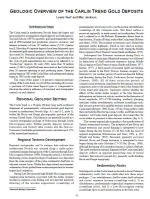Добрый день, Коллеги. Важное сообщение, просьба принять участие. Музей Ферсмана ищет помощь для реставрационных работ в помещении. Подробности по ссылке
Geologic overview of the Carlin trend gold deposits / Геологический обзор золоторудных месторождений Карлин-Тренд
The Carlin trend in northeastern Nevada forms the largest and most productive accumulation of gold deposits in North America. Teal and Jackson (1997b) reported a gold endowment that by the end of 1996 included past production, reserves, resources, and mineral inventory of over 107 million ounces (3,330 t [metric tons]). More than 40 separate deposits have been delineated since disseminated gold mineralization in carbonate host rocks was first discovered by Newmont geologists John Livermore and Alan Coope in 1961. From their original discovery, a classification for this style of gold mineralization has come to be referred to as “Carlin-type” deposits. By early 2002, more than 50 million ounces (1,560 t) of gold had been recovered on the Carlin trend from 26 separate operating or past producing mines. Open-pit mining began in 1965 at the Carlin Mine, and underground mining began in 1993 on the same deposit.
The scope of this paper is to present a regional geologic setting of the Carlin trend. As part of the concluding discussion, a spectrum of Carlin trend deposit types is categorized to illustrate the relative influence of structural and stratigraphic controls on each deposit.




